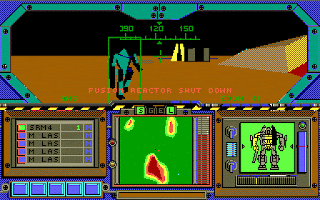Hard Drivin’ is a cabinet game meant to simulate driving a real sports car, and simulated force feedback in the steering wheel, as well as a clutch and pedal and the possibility to stall the car if you don’t operate it properly. It used some of the first 3D polygon graphics (previously everything was done with scaling 2D sprites), and each cabinet cost $10,000. You play in first person perspective, driving a Ferrari Testarossa. If you score among the top 10 players, you can race against the computer controlled “Phantom Photon”, serving sort of like a boss fight for the game.
It featured an instant replay system that lets you see your crash from a cinematic perspective after you go down, which was pretty new for the time. It also had a very complicated physics system including your car's engine, tire and suspension physics, and transmission control simulation. Besides making a few innovations in the racing genre, the game also had four sequels and many ports, despite initial poor reviews.
SimCity Classic
SimCity, later renamed SimCity Classic, is a city-building strategy/simulation game made by Maxis Studios and designed by Will Wright. Wright made this game based on his interest in level editors in games. He always found that he enjoyed the editors in games more than the games themselves, and so he created SimCity based on this idea. SimCity doesn’t have any traditional goal (other than in their scenarios mode, which I’ll talk about later). Instead, you just build up a city from nothing (literally, you start with a patch of dirt and some trees), building city districts like residential or commercial neighbourhoods, manage your taxes, upgrade with new technologies, and more.
However, not all is well in pixel town! You will have to survive random events like floods, traffic congestion, tornados, earthquakes, immigrants (just kidding about that one), train crashes, and even monster attacks! However, the producers didn’t feel that these events were enough to add structure to the game, and thought they needed some kind of goal to keep players interested, and so scenario mode was born. In this mode, you start with an already built city (usually real cities) and have to solve either real historical problems, or made up events. For example, you can play as a swedish mayor who has to solve your city’s traffic problems, or stop a nuclear generator meltdown in Boston, or even defend the city from an alien invasion in Las Vegas (that escalated quickly).
When Will Wright first proposed SimCity, he was told that it was like “a doll house for computers” and told it wouldn’t sell. Of course, SimCity went on to be one of the most successful game franchises ever, popularizing both simulation games and making games without specific goals acceptable in the industry. It has since been called one of the three most important innovations in gaming history. It was also used for urban planning and political science in the universities of South California and Arizona, and won many awards. It spawned many SimCity games, as well as the “The Sims” series and Spore.
MechWarrior
MechWarrior, the first game in the BattleTech series, was a first-person mech fighting RPG game. In this game, you can make choices in the story arc, choose missions, sell and buy mech parts, hire companions, and explore the world (called the Inner Sphere). In the story, you play as Prince Gideon Braver Vandenburg, whose family is murdered. The chalice that proves you are the rightful heir has been stolen, and you must build up an army of mech warriors and forcefully take back your throne, within five years.
In terms of gameplay, MechWarrior has three main mechanics. Politics are a large part of the game, and maintaining a good reputation with the five main houses is important. If you fall too far out of favor, you will have to fight them in several missions. However, if they like you, they will give you very profitable missions.
The second element is the trade system. You can make good profits by trading in mech parts and mechs themselves, buying from one planet and selling to another. You can also hire recruit MechWarriors, the quality of which is affected by your reputation.
The third element is their combat system. You played first person in the cockpit of a mech, with simple flat-looking 3D shaded graphics, which actually served the game well, and made it easy to quickly identify enemy mechs. You could choose from up to eight different mech designs, each with their own advantages and disadvantages in different situations. You also played alongside the AI recruits you had, and could give them basic orders.
Hard Drivin’
SimCity
MechWarrior







No comments:
Post a Comment